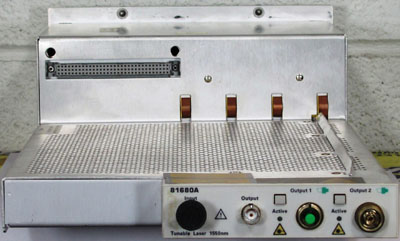
|
|
The Agilent 81680A Tunable Laser module (back-loadable) fit into the Agilent 8164A, 8164B Lightwave Measurement System and the Agilent 8166A, 8166B Lightwave Multichannel System. Have a built-in wavelength control loop. As it is made mode-hop free tunable with continuous output power, it qualifies to test the most critical DWDM components. The Agilent 81680A module is ideally constructed to characterize integrated optical devices. It's Panda PMF output ports provide a well-defined state of polarization to ensure constant measurement conditions on waveguide devices. A PMF cable easily connects an external optical modulator. The Agilent 81680A tunable laser module is equipped with two optical outputs. One output port delivers a signal with ultra-low source spontaneous emission (SSE). It enables accurate crosstalk measurement of DWDM system components with many channels at narrow spacing. A power meter module alone is sufficient to characterize steep notch filters, such as Fiber Bragg Gratings. The second output port provides increased optical power and allows adjustment by more than 60 dB through a built-in optical attenuator. Specifications. Wavelength Range: 1460 nm to 1580 nm. Wavelength resolution: 0.1 pm, 12.5 MHz at 1550 nm. Tuning Speed: 400 ms/600 ms/2.8 s (typ. For a 1/10/100 nm step). Absolute wavelength accuracy: ±10 pm. Relative wavelength accuracy: ±5 pm, typ. ±2 pm. Wavelength repeatability: ±1 pm, typ. ±0.5 pm. Wavelength stability: <= ±1 pm (typ. 24 hrs at constant temp.). Output 1 low source spontaneous emission (SSE): Max Power: >= -4 dBm peak typical; Min. Power: -13 dBm. Output 2 Max. Power: >= +6 dBm peak typical; Min. Power: -3 dBm (-60 dBm in attenuation mode). Option 071: Polarization Maintaining Fiber, straight contact connector. Option 072: Polarization Maintaining Fiber, angled contact connector.
|